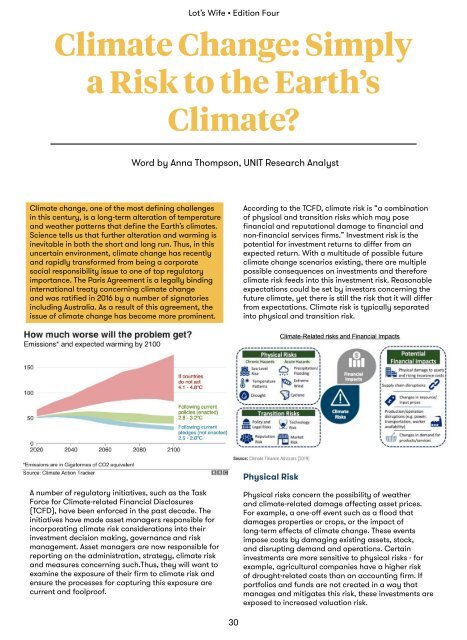You also want an ePaper? Increase the reach of your titles
YUMPU automatically turns print PDFs into web optimized ePapers that Google loves.
Lot’s <strong>Wife</strong> • <strong>Edition</strong> Four<br />
Lot’s <strong>Wife</strong> • <strong>Edition</strong> Four<br />
Climate Change: Simply<br />
a Risk to the Earth’s<br />
Climate?<br />
Word by Anna Thompson, UNIT Research Analyst<br />
Climate change, one of the most defining challenges<br />
in this century, is a long-term alteration of temperature<br />
and weather patterns that define the Earth’s climates.<br />
Science tells us that further alteration and warming is<br />
inevitable in both the short and long run. Thus, in this<br />
uncertain environment, climate change has recently<br />
and rapidly transformed from being a corporate<br />
social responsibility issue to one of top regulatory<br />
importance. The Paris Agreement is a legally binding<br />
international treaty concerning climate change<br />
and was ratified in 2016 by a number of signatories<br />
including Australia. As a result of this agreement, the<br />
issue of climate change has become more prominent.<br />
A number of regulatory initiatives, such as the Task<br />
Force for Climate-related Financial Disclosures<br />
(TCFD), have been enforced in the past decade. The<br />
initiatives have made asset managers responsible for<br />
incorporating climate risk considerations into their<br />
investment decision making, governance and risk<br />
management. Asset managers are now responsible for<br />
reporting on the administration, strategy, climate risk<br />
and measures concerning such.Thus, they will want to<br />
examine the exposure of their firm to climate risk and<br />
ensure the processes for capturing this exposure are<br />
current and foolproof.<br />
According to the TCFD, climate risk is “a combination<br />
of physical and transition risks which may pose<br />
financial and reputational damage to financial and<br />
non-financial services firms.” Investment risk is the<br />
potential for investment returns to differ from an<br />
expected return. With a multitude of possible future<br />
climate change scenarios existing, there are multiple<br />
possible consequences on investments and therefore<br />
climate risk feeds into this investment risk. Reasonable<br />
expectations could be set by investors concerning the<br />
future climate, yet there is still the risk that it will differ<br />
from expectations. Climate risk is typically separated<br />
into physical and transition risk.<br />
Physical Risk<br />
Physical risks concern the possibility of weather<br />
and climate-related damage affecting asset prices.<br />
For example, a one-off event such as a flood that<br />
damages properties or crops, or the impact of<br />
long-term effects of climate change. These events<br />
impose costs by damaging existing assets, stock,<br />
and disrupting demand and operations. Certain<br />
investments are more sensitive to physical risks - for<br />
example, agricultural companies have a higher risk<br />
of drought-related costs than an accounting firm. If<br />
portfolios and funds are not created in a way that<br />
manages and mitigates this risk, these investments are<br />
exposed to increased valuation risk.<br />
Stranded Assets<br />
Stranded assets are those which are unexpectedly<br />
devalued as a result of climate related events. When<br />
physical risks, such as the risk of climate events<br />
destroying particular physical inventories or certain<br />
sectors becoming obsolete as a result of a regulatory<br />
or societal retreat from activities which contribute to<br />
climate change, materialise, they can result in assets<br />
becoming stranded.<br />
Stranded assets pose risks to investments and are<br />
often used as the general unit of measurement when<br />
debating the possible financial impacts of climate risk.<br />
The London School of Economics estimated the value<br />
of global financial assets that are at risk from climate<br />
change as being US$2.5 trillion, while The Economist<br />
estimated it as being US$4.2 trillion. Stranded assets<br />
are important in managing financial risk to attempt to<br />
avoid loss after an asset has become a liability. Asset<br />
managers are expected to be wary of the possibility of<br />
investing portfolios or funds in companies or sectors<br />
prone to stranded asset risk. However, re-positioning<br />
portfolios due to possible stranded assets needs to be<br />
adequately explained by asset managers due to the<br />
possibility of incurring unnecessary costs for investors<br />
and compromising their returns.<br />
Transition Risk<br />
As discussed above, there is mounting regulatory<br />
pressure on companies to alter their operations and<br />
activities in order to mitigate negative environmental<br />
externalities. Coupled with heightened social pressure,<br />
risks arise as a resulting shift towards a greener, lowcarbon<br />
economy.<br />
This is the transition risk. As climate change worsens,<br />
market participants are likely to change their<br />
attitudes: governments may become more open to<br />
taxing emissions, and consumers may shift their<br />
demand towards more environmentally friendly<br />
products. This creates transition risk such as:<br />
• The risk of consumers switching to invest in firms<br />
with more environmentally-friendly track records;<br />
• The risk of firms with high carbon emissions<br />
facing high future regulatory costs;<br />
• Or the risk of media announcements regarding<br />
harmful environmental practices that can<br />
negatively affect a company’s market value.<br />
Conclusion<br />
Climate risk is persistent and will continue to evolve<br />
into the distant future. As a result, institutions must<br />
integrate considerations of this risk into their business<br />
strategies, and risk management and governance<br />
processes in order to not only keep up with the<br />
increasing regulations but also ensure their business<br />
can survive in the long-term. As climate change<br />
is a problem that will persist long into the future,<br />
addressing climate risk is something that needs to be<br />
integrated into everyday decision-making, rather than<br />
being a one-off process.<br />
Monash students can be aware and informed of<br />
the impacts of climate risk and the signs of a firm<br />
adequately handling this risk and having a forwardlooking<br />
attitude. This will assist in making informed<br />
financial decisions.<br />
30 31


















